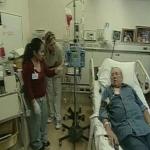25 March 2010

Seventy-five percent of cancers occur in adults 55 years or older.
Despite advances in prevention, diagnosis and treatment, cancer remains the second-leading cause of death in the United States. The disease - in all its forms - struck 1.5 million Americans last year, killing 560,000. These trends are reported in a special issue of the Journal of the American Medical Association, entirely devoted to cancer research.
Progress on Cancer Front
The good news is that progress against cancer has been made on many fronts, says Susan Gapstur, vice president of Epidemiology at the American Cancer Society and co-author of a commentary in the journal. She says mortality rates in the United States peaked for men in 1990 and for women in 1991. Mortality rates have come down by about 21 percent and 12 percent in women.
About 40 percent of the decrease for men resulted from the decline in lung cancer death. Gapstur credits the reduction in cigarette smoking, sparked by education campaigns, smoke-free laws, taxes and social policies for that. She says great strides have also been made in early detection for a number of other cancers.
"Our best success has been in pap smear, for the detection of cervical changes before actually the occurrence of cancer," says Gapstur. "Also colorectal cancer screening [is] another very important tool that can detect changes in the colon prior to the incurrence of the cancer."
These tests, along with mammography for breast cancer, help detect cancers at very early stages and increase chances of survival.
Age and Risk
Seventy-five percent of cancers occur among adults 55 years or older. Gapstur notes that as the number of older Americans has increased, so has the lifetime risk of cancer, to one-in-every-two men and one-in-every-three women.
One article in the journal reports that while older adults are less likely to receive chemotherapy following colon surgery, they tolerate it better than younger patients and don't get as sick from the therapy. Journal editor Catherine
DeAngelis says another article describes the high success rate of tumor control for a new form of radiation for inoperable lung cancer. "That's a preliminary communication, meaning we don't quite know the answer yet, but boy it looks like we are on to something big," says DeAngelis.
The targeted therapy controlled tumor growth for three years in 98 percent of the lung cancer patients.
War Continues
DeAngelis says while 11 million Americans alive today have either survived or are going through treatment, the war on cancer is far from over.
She says that's in part because the disease, in all its various biological forms, is so complicated. "There's a commonality to cancer as a disease entity, but the organ it attacks makes it quite different, and the way it presents and the way it acts and the way it needs to be treated. I think that's part of the frustration."
DeAngelis says the strategy going forward must be to fight the battle on many fronts, building on the lessons learned from research, detection and treatment. Susan Gaspstur with the American Cancer society adds that to get the numbers down,"It is essential that we continue to advocate for access to preventation for all and dissemination of what we know about prevention."